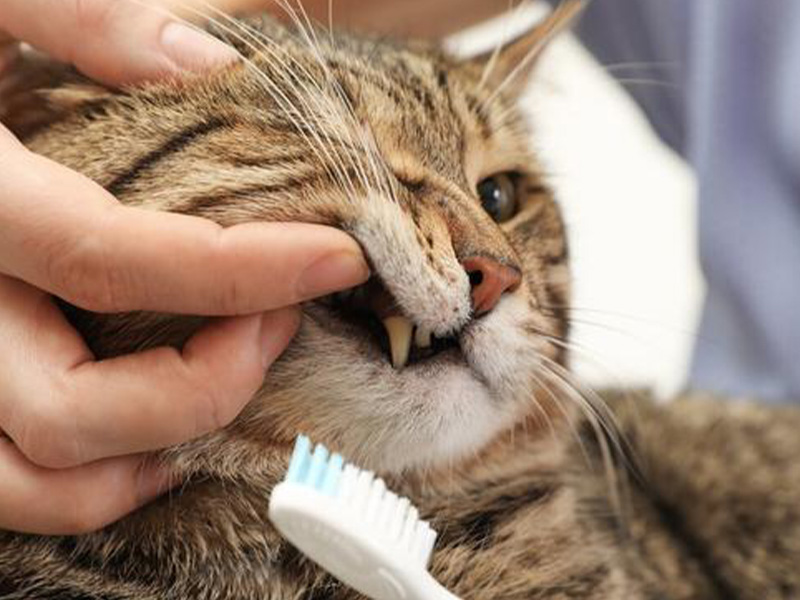
แมวสื่อสารเรื่องฟันเจ็บไม่ได้ แต่คราบหินปูนนำไปสู่โรคเหงือก กลิ่นปาก และอาจถึงขั้นหลุดร่วงได้ ในฐานะเจ้าของที่รับผิดชอบ จึงควรเข้าใจการเกิดคราบหินปูนและวิธีป้องกัน บทความนี้ครอบคลุมทั้งวิธีทำเองและบริการสัตวแพทย์ พร้อมคำแนะนำป้องกัน
การเกิดคราบหินปูนในแมว
เศษอาหาร & แบคทีเรีย: หลังให้อาหาร เศษอาหารติดระหว่างซี่ฟันและแนวเหงือก
การเกิดคราบพลัค: แบคทีเรียในช่องปากกินเศษอาหารสร้างพลัค (biofilm) ชนิดเหนียว
การแร่ธาตุ: ใน 24–72 ชั่วโมง แร่ธาตุในน้ำลายทำให้พลัคแข็งกลายเป็นหินปูน
ความเสี่ยงทางสุขภาพ: คราบหินปูนที่ไม่รักษา ทำให้เหงือกอักเสบ (gingivitis), กลายเป็นโรคปริทันต์ (periodontitis) และทำลายรากฟันได้
ควบคุมคราบหินปูนที่บ้าน
- แปรงฟันทุกวัน
• อุปกรณ์: ใช้แปรงขนนุ่มสำหรับสัตว์เลี้ยงและยาสีฟันเอนไซม์สำหรับแมว ห้ามใช้ยาสีฟันคน
• เทคนิค: ยกริมฝีปากแมวขึ้น แปรงเป็นวงกลมเล็ก ๆ ริมเหงือก 30–60 วินาทีต่อข้าง จากนั้นให้รางวัลด้วยคำชมหรือขนม
• ความสม่ำเสมอ: แปรง 1 ครั้ง/วัน หรืออย่างน้อย 3–4 ครั้ง/สัปดาห์ก็ช่วยได้มาก
- อาหารและขนมเพื่อฟัน
• อาหารเม็ด: สูตรพิเศษเม็ดใหญ่และแข็งกว่าสูตรปกติ ช่วยขัดฟันเวลาที่แมวเคี้ยว
• ขนมแลกคะแนน: เลือกขนมผ่านการรับรอง VOHC เนื้อกรอบช่วยขจัดพลัคก่อนแข็งตัวเป็นหินปูน
- น้ำยาบ้วนปาก & เจล
• น้ำยาฆ่าเชื้อ: ใช้น้ำยาคลอร์เฮกซิดีนปลอดภัยสำหรับแมว ทาบด้วยสำลีลดแบคทีเรีย
• เจลป้องกันคราบหินปูน: เจลเอนไซม์ละลายคราบหินปูนบาง ๆ ทาบนซี่ฟัน 1–2 ครั้ง/สัปดาห์
เมื่อใดควรพาไปขูดหินปูนมืออาชีพ
สัญญาณที่ควรพบสัตวแพทย์:
• คราบสีเหลืองหรือน้ำตาลตามแนวเหงือก
• เหงือกแดง บวม หรือมีเลือดออก
• กลิ่นปากแรงมาก
• กินลำบากหรือน้ำลายยืดเยื้อ
การขูดหินปูนด้วยอัลตราซาวนด์
• ขั้นตอน: ให้แมวดมยาสลบ แพทย์ใช้เครื่องอัลตราซาวนด์ขจัดหินปูนบน-ใต้แนวเหงือก
• การตรวจก่อนผ่า: ตรวจเลือดและตรวจร่างกายยืนยันความปลอดภัยการดมยาสลบ
• การฟื้นตัว: แมวส่วนใหญ่กลับบ้านได้วันเดียวกัน คอยสังเกตกินข้าวและพฤติกรรม 24 ชั่วโมงแรก
การติดตามผล & ถอนฟัน
• หากเป็นปริทันต์ขั้นรุนแรงอาจต้องถอนฟัน
• ใช้ยาต้านอักเสบหลังขูดลดอาการเจ็บและบวม
ป้องกันการเกิดซ้ำของหินปูน
1. ทำเป็นนิสัย: แปรงฟันทุกวัน + อาหารและขนมเพื่อฟัน
2. ตรวจสุขภาพประจำปี: ตรวจช่องปากในการตรวจสุขภาพครึ่งปี
3. ให้ความชุ่มชื้น: น้ำสะอาดตลอดเวลา ช่วยชะล้างเศษอาหารและแร่ธาตุ
4. ของเล่นเคี้ยวได้: ของเล่นสำหรับเคี้ยวช่วยขัดถูผิวฟันตามธรรมชาติ
